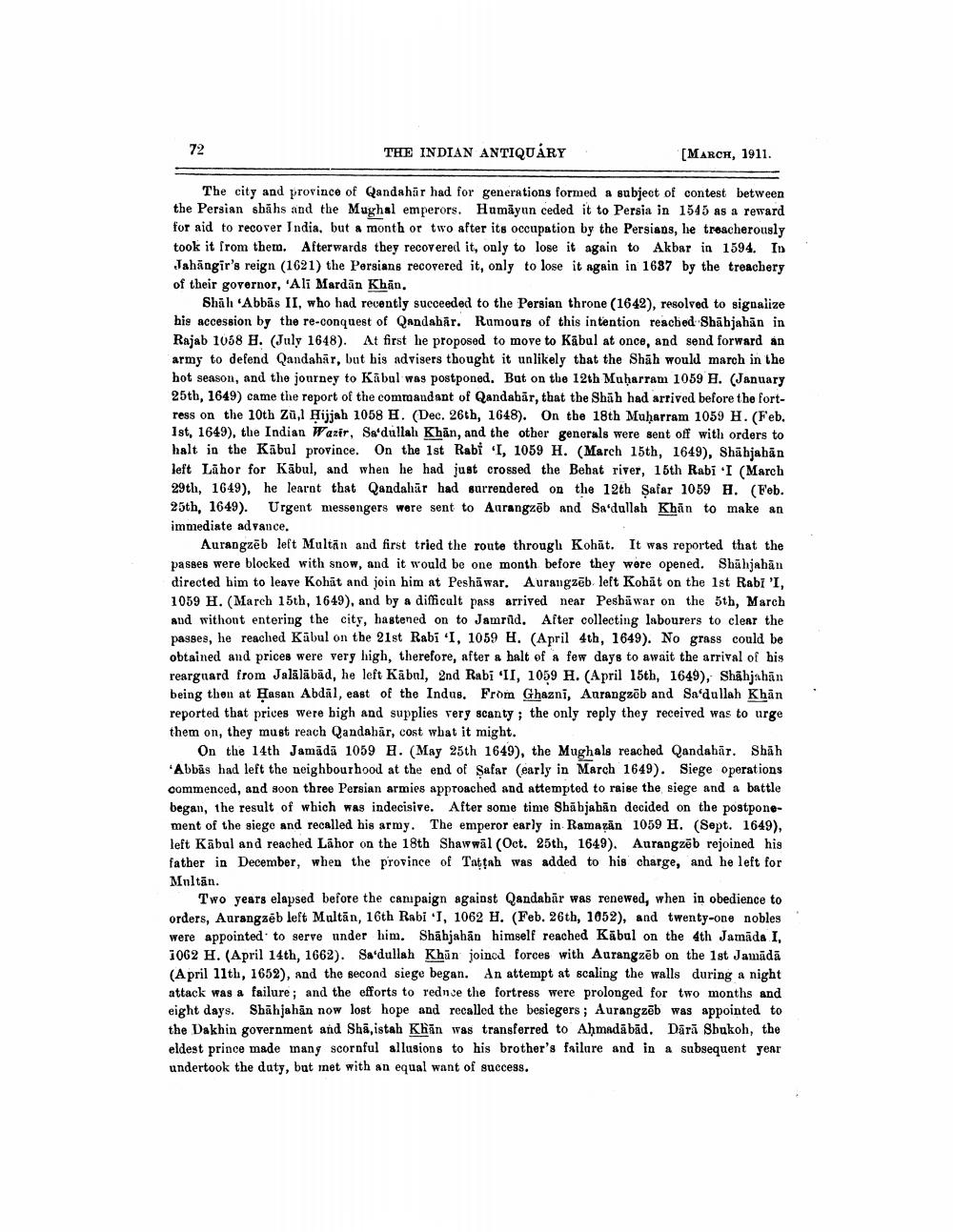________________
THE INDIAN ANTIQUÁRY
[MARCH, 1911.
The city and province of Qandahār had for generations formed a subject of contest between the Persian shāhs and the Mughal emperors. Humayun ceded it to Persia in 1545 as a reward for aid to recover India, but a month or two after its occupation by the Persians, he treacherously took it from thero. Afterwards they recovered it, only to lose it again to Akbar in 1594. In Jahangir's reign (1621) the Persians recovered it, only to lose it again in 1687 by the treachery of their governor, 'Ali Mardān Khān.
Shah Abbas II, who had recently succeeded to the Persian throne (1642), resolved to signalize his accession by the re-conquest of Qandabar. Rumours of this intention reached Shāhjahān in Rajab 1058 1. (July 1648). At first he proposed to move to Kabul at once, and send forward an army to defend Qandahar, but his advisers thought it unlikely that the Shah would march in the hot season, and the journey to Kābal was postponed. But on the 12th Muharram 1059 . (January 25th, 1649) came the report of the commandant of Qandabār, that the Shah had arrived before the fortress on the 10th Zül Hijjah 1058 H. (Dec. 26th, 1648). On the 18th Muharram 1059 H. (Feb. 1st, 1649), the Indian Wazir, Sa'dullah Khān, and the other generals were sent off with orders to halt in the Kábul province. On the 1st Rabi 'I, 1059 H. (March 15th, 1649), Shāhjahān left Lāhor for Kabul, and when he had just crossed the Behat river, 15th Rabi I (March 29th, 1649), he learnt that Qandahar had surrendered on the 12th Şafar 1059 H. (Feb. 25th, 1649). Urgent messengers were sent to Aurangzēb and Sa'dullah Khan to make an immediate advance.
Aurangzēb left Multan and first tried the route through Kohāt. It was reported that the passes were blocked with snow, and it would be one month before they were opened. Shāhjahān directed him to leave Kohāt and join him at Peshawar. Aurangzēb left Kohāt on the 1st Rabi 'I, 1059 H. (March 15th, 1649), and by a difficult pass arrived near Peshawar on the 5th, March and withont entering the city, bastened on to Jamrid. After collecting labourers to clear the passes, he reached Kábul on the 21st Rabi 'I, 1059 H. (April 4th, 1649). No grass could be obtained and prices were very high, therefore, after a halt of a few days to await the arrival of his rearguard from Jalālābād, he left Kabul, 2nd Rabi 'II, 1059 H. (April 15th, 1649), Shāhjahan being then at Hasan Abdal, east of the Indus. From Ghazni, Aurangzēb and Sa'dullah Khan reported that prices were bigh and supplies very scanty; the only reply they received was to urge them on, they must reach Qandahār, cost wbat it might.
On the 14th Jamādā 1059 H. (May 25th 1649), the Mughals reached Qandabār. Shāh *Abbās had left the neighbourhood at the end of Şafar (early in March 1649). Siege operations commenced, and soon three Persian armies approached and attempted to raise the siege and a battle began, the result of which was indecisive. After some time Shābjahān decided on the postponement of the siege and recalled his army. The emperor early in Ramazan 1059 H. (Sept. 1649), left Kābal and reached Lahor on the 18th Shawwal (Oct. 25th, 1649). Aurangzēb rejoined his father in December, when the province of Tattah was added to his charge, and he left for Multān.
Two years elapsed before the campaign against Qandabār was renewed, when in obedience to orders, Aurangzeb left Maltān, 16th Rabi 'I, 1062 H. (Feb. 26th, 1052), and twenty-one nobles were appointed to serve under him. Shāhjahan himself reached Kābul on the 4th Jamāda I, 1062 H. (April 14th, 1662). Sa'dullah Khan joined forces with Aurangzēb on the 1st Jamādā (April 11th, 1652), and the second siege began. An attempt at scaling the walls during a night attack was a failure; and the efforts to rednje the fortress were prolonged for two months and eight days. Shāhjahān now lost hope and recalled the besiegers; Aurangzēb was appointed to the Dakhin government and Shā,istah Khān was transferred to Ahmadābād. Dārā Shukoh, the eldest prince made many scornful allusions to his brother's failure and in a subsequent year undertook the daty, but met with an equal want of success.




